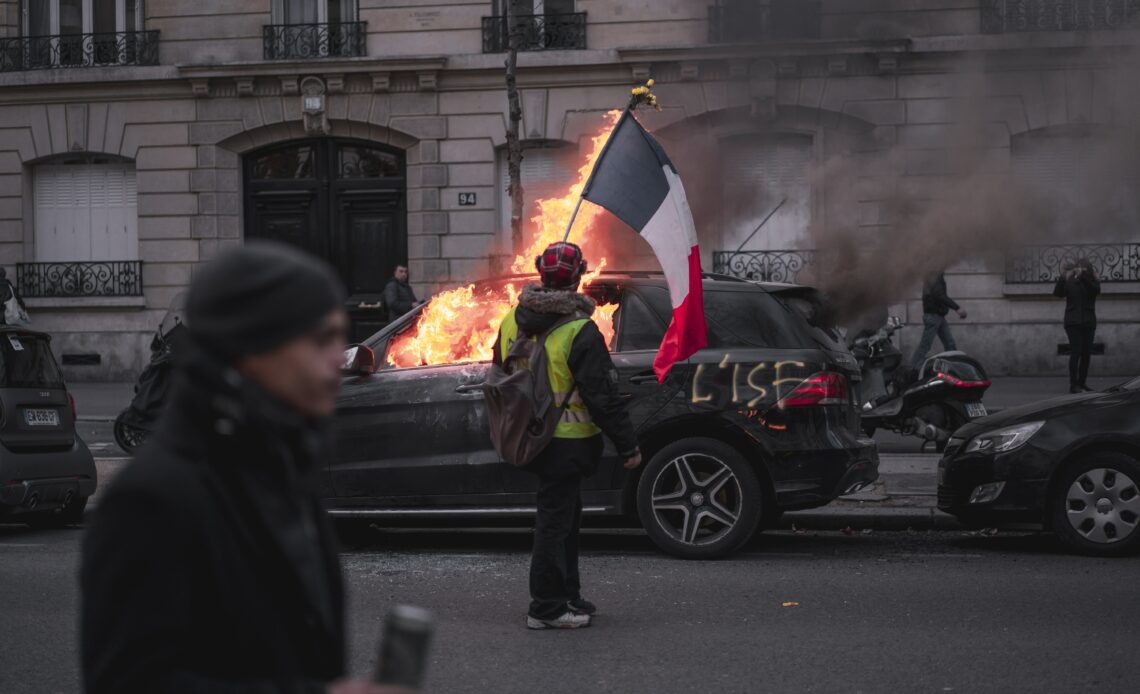
Whether you support or suppress protesters, history shows that dissent is necessary for social growth and collective renewal. (Micah White 2016)1
The question presented above may sound paradoxical, but it has always been close to debates and theories about growing societal justice, and it is very timely with protests in France, the Black Lives Matter movement, and protests by climate activists. Should there be boundaries for protest movements, and if so, how should they be defined? Can there be change without (at least symbolic) acts of violence?
In European history, this question has been highly debated before, for instance during and after the French Revolution (also during the Reformation or the Wars of the Three Kingdoms, etc.). Most European intellectuals actually favoured a revolution before 1792, but, after seeing the implications and outcomes of the Reign of Terror (la Terreur), changed their tune. Friedrich Schiller, the German poet and author, who was awarded an honorary citizenship of France in 1792, sharply criticised the consequences of the French Revolution after 1793 and wrote a non-violent alternative proposal with his work On the Aesthetic Education of Man (1795). Despite all criticism, it is clear that the French Revolution has had a profound impact on the history of European politics and expanded the development of modern state constitutions. Hence, the question arises if those changes would have been possible without a violent revolution?2
When we think of environmental issues or apparent social injustice, it has often been argued that things need to change fast. To achieve this quick and profound change in policy and behaviour, more radical action might be required to make it happen. Like Maria J. Stephan and Erica Chenoweth (2008) mention: “Scholars often assume that violent methods of resistance are the most coercive or the most likely to force accommodation, thereby producing desired policy changes.”3 Regardless of the moral concerns one might have, it is simply the most successful way to achieve the desired goals – at least, that is what these lines of thought suggest.
Stephan and Chenoweth (2008) argue in their article Why Civil Resistance Works that, despite the often-expressed view that violent resistance campaigns4 are more effective, nonviolent campaigns5 have higher probabilities to achieve success than violent resistance campaigns. They support their statement based on empirical findings and by statistically comparing the results of “323 violent and nonviolent resistance campaigns from 1900 to 2006.”6 Their main argument is that it is more difficult to repress a nonviolent campaign, because physical acts against such a campaign or movement may backfire – meaning, that it might have negative effects for the repressing part (a repressing regime for example). This physical repression, in turn, “leads to power shifts by increasing the internal solidarity of the resistance campaign, creating dissent and conflicts among the opponent’s supporters, increasing external support for the resistance campaign, and decreasing external support for the opponent.”7 Further, “members of a regime—including civil servants, security forces, and members of the judiciary—are more likely to shift loyalty toward nonviolent opposition groups than toward violent opposition groups.“8 These shifts do not happen when violent resistance campaigns are repressed, as Stephan and Chenoweth’s (2008) empirical studies show. Therefore, acts of violence may, even without any consideration on ethics, not be the best or most efficient way to initiate political or societal change.
An example speaking against the processes of nonviolent protest described above, can be found in Micah Whites description of the spread of the Occupy Wall Street movement.9 White (2016) describes that they did everything a nonviolent protest movement should do, to be successful. He explicitly describes the expectation of a backfire as described above, but despite great media representation, nothing happened. They were violently shut down by state institutions and the backfire did not occur. “But the second part of our story of change, the faith that brutal repression of dignified Occupiers would backfire against the United States, proved to be wrong.”10 And again: “Occupy was mass, modern, secular […] and overwhelmingly nonviolent during its peak. […] Occupy was nearly a textbook example of a movement that should work […] And then we were defeated.”11
That devastating conclusion does not imply that they instead should have relied on violent acts (not to forget that, at least in some countries, violent acts did occur during the Occupy Wall Street protests). This would not have changed the outcome of the protest: it probably would have made things worse and, even though the big objectives of the protest were not reached, it also would have diminished the positive results White (2016) still sees.
But the question remains: How should we act if nonviolent protests or movements do not lead to any or just some minor results? Don’t we have to force things more radically? Andreas Malm, a Swedish author and associate professor for human ecology writes in his book How to blow up a pipeline (2021)12 about his frustration with climate protests and movements, which stick to a “strict commitment to absolute nonviolence.”13 Since decades of nonviolent protest did not bring us anywhere close to what has to be done, he asks “When do we start physically attacking the things that consume our planet and destroy them with our own hands?”14 Malm (2021) does not suggest violent acts against specific people, but he calls for targeted sabotage to force companies or businesses that emit high amounts of CO2 to stop. Does he have a point here? Is there not something appealing to this position? At least a hint of romanticism, that people stand up for their ideals, rights, and our planet; to actively defend them?
To draw a first conclusion on this point: we saw through the study by Stephan and Chenoweth (2008) that nonviolent movements and protests have higher probabilities of lasting success (like described above). We further saw with White’s (2016) reflection on the Occupy Wall Street movement that the effects described by Stephan and Chenoweth (2008) may not always occur, and we questioned with Malm (2021) whether that does not imply that we should shift our strategies to more radical positions? This last move we can currently observe happening in many countries.
Despite Malm’s (2021) objection, fundamental changes, both in institutionalized systems and prevailing thought patterns, are complicated processes, and more violent approaches do not accelerate them but rather further polarize them. Damaged production facilities can be repaired again if fundamental mental changes do not occur in a widespread manner. Therefore, I would advocate for promoting nonviolent methods and continuing to stand up for change, even if at times it feels like nothing is moving.
One fundamental question that has not been fully addressed and analysed in this article is: How do we define violence? Is, to give an example, throwing a brick through a glass window of a shop a violent act? In this article, it has been assumed that it is, but a differentiated philosophically founded position on this part, lies at the centre of further investigations. Therefore, I want to end with a little cliff-hanger and give an outlook on further studies, in which I would like to pursue these questions further, drawing connections to the problem of identity and theories of recognition. Finally, to give Shakespeare the last word on this: “These violent delights have violent ends.”15 (Romeo and Juliet act 2, scene 6)
1 White, Micah: The end of protest. A new playbook for revolution. Toronto: Knopf Canada. 2016.
2 Some interesting thoughts can be found within Walter Benjamin’s Critique of Violence; available online: https://criticaltheoryconsortium.org/wp-content/uploads/2018/05/Benjamin-Critique-of-Violence-1.pdf
3 Stephan, Maria J.; Chenoweth, Erica: „Why Civil Resistance Works: The Strategic Logic of Nonviolent Conflict” In: International Security. Bd. 33. H. 1. 2008. S. 7–44, p. 10
4 “Nonviolent resistance achieves demands against the will of the opponent by seizing control of the conflict through widespread noncooperation and defiance. Violent coercion threatens physical violence against the opponent.” p. 10
5 „Nonviolent resistance is a civilian-based method used to wage conflict through social, psychological, economic, and political means without the threat or use of violence. It includes acts of omission, acts of commission, or a combination of both.“ p. 9; and “Nonviolent struggle takes place outside traditional political channels, making it distinct from other nonviolent political processes such as lobbying, electioneering, and legislating.” p. 10
6 ibid. p. 15
7 ibid. p. 11
8 ibid. p. 11
9 White: The end of protest. 2016, p. 21ff.
10 ibid. p. 24
11 ibid. p. 32-33
12 Malm, Andreas: How to blow up a pipeline. Learning to fight in a world on fire. London/New York: Verso. 2021.
13 https://www.bookforum.com/interviews/bookforum-talks-with-andreas-malm-about-his-new-book-how-to-blow-up-a-pipeline-learning-to-fight-in-a-world-on-fire-24359 (last opened: 24.07.2023)
14 Malm, Andreas: How to blow up a pipeline. Learning to fight in a world on fire. London/New York: Verso. 2021, p. 9
15 Shakespeare, William: The complete works of William Shakespeare. Ware: Wordsworth Edition. 2007, p. 260

About the Author: Simon Elias Unteregger
Simon Elias Unteregger is from Austria and has a background in German studies, biology, and philosophy. He is currently pursuing a Master’s Degree in German studies at the University of Salzburg. Together with his wife Nathalie, Simon lives in Salzburg and is a passionate reader of literary and philosophical works. He also enjoys writing poetry and short prose texts, as well as talking about aesthetics and possible art projects with his wife.

